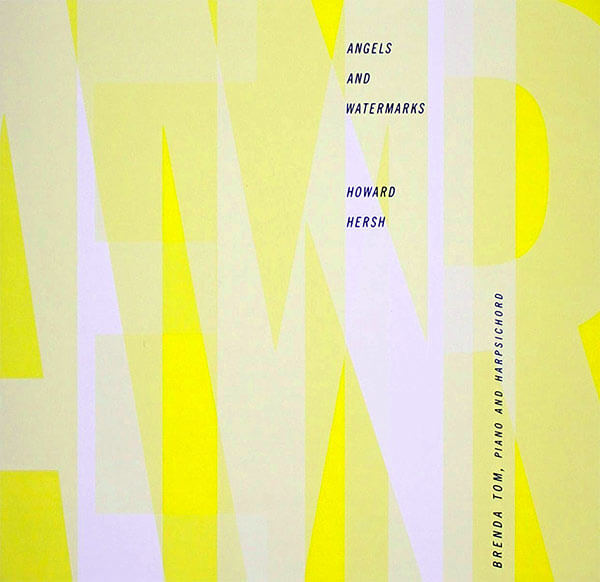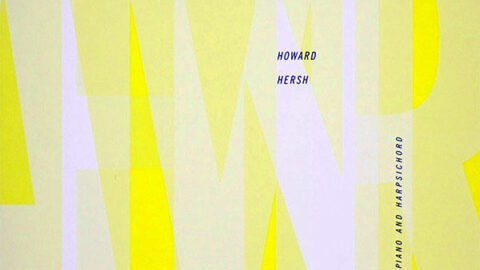
Angels and Watermarks is the latest self-released album (Snow Leopard Music) by Howard Hersh, an American composer who lives and works in the Sierra Foothills. The album, featuring soloist Brenda Tom on the piano and harpsichord plus a ten-piece ensemble under the direction of conductor Barbara Day Turner, serves as a rich and expansive reservoir of Hersh’s musical ideas. Just as a piece is thought to be of a certain attitude, mood, or style, the listener’s journey is then promptly ushered towards new pathways to follow and new sounds to discover. Angels and Watermarks is hard to pin down as a result, but it is without a doubt an exuberant musical experience, one chock-full of inventive surprises.
The first piece on the album, Concerto for Piano and Ten Instruments (2008), consists of three movements which are best described as rhizomes or lines of flight. Each movement seems to grow sideways from an initial seed of thought, extending outwards at adventitious intervals rather than striving towards conventional resolves. The result is a weaving together of truncated melodies and bursts of rhythm across all instruments, sometimes jagged and other times billowing. At sixteen minutes long, Movement I is perhaps the most thorough example of this in action. Movement II, on the other hand, consists of these same elements but is delightful, gentler, and more romantic in nature. It serves as a much needed complement to Movement III which, although tightly wound, portrays disquiet in an incredibly flattering manner. This is a testament to both Hersh’s artistry as well as to the courageous efforts of Brenda Tom and the ten-piece ensemble.
Next is Angels and Watermarks (2004) which was composed by Hersh at the Djerassi Resident Artists Program in Woodside, California. The piece was inspired by a section from Black Spring by writer Henry Miller entitled The Angel Is My Watermark!. In this essay, the narrator – Miller himself as a painter – gives voice to his unraveling thought process while attempting to excavate symbolic meaning from his work. Peeling back all the layers, whether by mistake or with intention, ultimately leads him to his Muse, the realization that the masterpiece is in fact nothing if not the process itself.
Hersch’s work parallels this sentiment in many ways, but for him the angel is the harpsichord, an instrument whose voice is revealed to be simultaneously baroque in sound and futuristic in language. The suite begins with Before (Angels) which points toward the past with its traditional ornamentation. The harmonies, however, are by no means orthodox; this is later referenced in the spectral postlude properly entitled After (Watermarks). Sandwiched in between are Flying Lessons, a video game-esque study in perpetual motion; Little Angel Dreams, a chameleonic lullaby; and Touch, a homage to the toccata with a hint of the blues. Tom’s performance of Angels and Watermarks is captivating as she transforms the harpsichord into an instrument of infinite charms.
Last on the album is Dream (2012), a breathtaking piece dedicated to its solo performer. Unlike the other two compositions on the album, this piece is subtle, slow, and surprisingly steadfast. Here, Tom is given ample amounts of time and space to consider the piano’s delicacies, and she does so with great tenderness. Hersh surprises yet again with this quiet close to an otherwise rowdy and energetic program.
Angels and Watermarks: A unique body of work
Overall, the audio quality on this self-produced album is commendable. Given the cinematic and far-reaching breadth of the Concerto, however, the recording may benefit from a crisper, deeper, and at times more precise sound. Upon closer listen, there is a notable difference between the acoustic setup of the instruments versus that of the piano which unfortunately creates a sonic divide between Tom and the ensemble. The album may also benefit from more liner notes to help guide listeners in their understanding of Hersh’s musical intentions and references. Minor technical faults aside, Angels and Watermarks is a truly unique body of work, an album that deserves to stand out for its fathomless embrace of ideas both old and new.
























